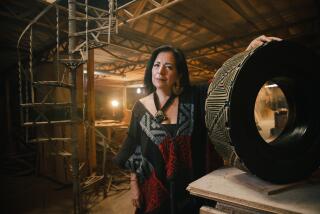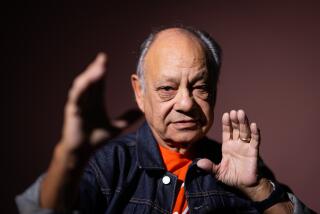Defining Our Own History : Chicano artists reinstate the art of the codex as a bridge between the indigenous and the contemporary in a Cal State Northridge show.
- Share via
In pre-Columbian times, the indigenous peoples of Mexico made accordion-like pictographic books from plants, animal skins and tree bark. Known as codices, their symbols and images told about the lives, traditions and histories of the Mayas, Mixtecs and Aztecs.
When the Spanish conquerors arrived in Mexico in the 16th Century, they destroyed these books in massive burnings. Today only 14 codices are known to exist, most of them held in European museums and private collections.
In response to last year’s 500th anniversary of Columbus’ arrival in the Americas, the Mexican Museum in San Francisco commissioned 26 Chicano artists from across the country to use pre-Columbian codices as a point of departure for documenting their personal histories as they relate to contemporary culture.
The complex and challenging works of those artists will be on view at Cal State Northridge’s Art Galleries beginning Monday in “The Chicano Codices: Encountering Art of the Americas.” It is the first show in the Mexican Museum’s series of four traveling exhibits, “Redefining the Aesthetic: Toward a New Vision of American Culture,” which is sponsored by a grant from the Lila Wallace-Reader’s Digest Fund.
The exhibit “proposes to reinstate the indigenous art form of the codex as a contemporary Chicano artistic medium while symbolically gathering the dispersed and destroyed pre-Hispanic picture books of the Americas,” writes curator Marcos Sanchez-Tranquilino in the exhibit catalogue’s essay.
Two years ago, the CSUN gallery presented the Mexican Museum’s show of Mexican folk art from Nelson Rockefeller’s collection. Gallery Director Louise Lewis said she was particularly drawn to its “Chicano Codices” exhibit because of its contemporary nature.
“It’s very Los Angeles or certainly Southern California. It confronts the very big issues that we’re confronting right now in the headlines of who is a Californian and who isn’t a Californian,” she said. “It’s a very strong statement about a long thread of our history and our background. To some it might be a bit controversial--even some of the ideas expressed--but there’s a very high level of spirituality that appeals to me here in these works and a tie-in with the sense of the environment, of nature.”
Sanchez-Tranquilino writes that rarely were the pre-Columbian codices named after their indigenous owners or the scribe / artist. Rather, they were identified by the person who “ ‘discovered,’ ‘purchased’ or otherwise ‘collected’ them,” he said. “Symbolically countering this European appropriation of the original codices, the Chicano codices are named after the artists who created them.”
These colorful, intricate, energetic expressions come in all shapes and mediums. A few artists fashioned their ideas in the original accordion-like codex structure that “worked almost like a comic book works,” said Lorenzo Flores, CSUN assistant professor of Chicano studies. Manuel (Spain) Rodriguez used a contemporary comic strip format to tell his story in “Codex ‘Spain’: Mexico and Me.”
In “Codex Quiroz: Pachucoatlotese,” Alfred J. Quiroz chose a multiple-box pattern to present the stylized images of pachuco culture in 1940s Los Angeles. Pachucos were young men and women who set themselves apart from the rest of society through, among other things, their clothing and hairstyles. With images of men in pachuco-style clothes, haircuts and tattoos, as well as U. S. military uniforms, Quiroz is “chronicling the pachuco here, and the idea of being from both sides of the border,” Flores said.
Emmanuel Catarino Montoya’s wheel-like “Codex Catarino: Reclaiming Language and Culture” takes viewers on a circular journey through assimilation into a way of life north of the Mexican border and his reconnection to the cultures of indigenous people south of the border.
Composed of five mixed-media pieces on canvas, “Codex Carrasco: Projex,” by Barbara Carrasco, presents a variety of icons specific to the ‘60s--including images of John Kennedy, Barbie, Wilma Flintstone and processed food. They are juxtaposed with more personal pictures and other references to the artist’s life then.
Commenting on the Western world’s dependence on oil, Celia Munoz’s “Codex Munoz: Petrocoatl, Aztec God del Fin del Mundo” includes personifying a fictitious deity through beads, feathers and a gas mask.
Like the pre-Columbian codices, several of the contemporary works make references to death. Flores believes that one reason the Spanish conquerors burned the codices was that “they were taken aback by some of the representations--for example, the skulls” that often appeared, he said.
The indigenous peoples were not afraid of death, Flores said. In fact, they embraced it. “The whole concept of duality was very prevalent within the cosmology of pre-Columbian people--the idea that every time you have one thing, you always have its opposite. If you’re born, by that nature you’re going to die. That concept of death was everywhere in a lot of the art.”
But to Europeans, such images were morbid. “According to the church, they were works of the devil,” he said. The colonials felt it necessary to “get rid of them, replace them with Bibles and bring Christianity to this heathen nation.”
Flores feels the exhibit is especially timely because “a lot of young Chicanos are finally discovering their Mexican-ness or their Chicano-ness,” he said. He described the term Chicano as “more a state of being rather than an identifiably ethnic kind of thing. The whole idea is that ‘Chicano’ is a term that we’ve given ourselves. It isn’t a term that was invented in Washington. It’s more of an encompassing term because we choose to call ourselves that.
“It’s a political state of mind. We’re here and we believe in the struggle for self-determination for people who are indigenous of this area or Mexican-American or indigenous to Mexico or Central America. I think a lot of the pieces are saying, ‘Hey, I’m here. I know I’m here and you’re going to have to accept that. And I have all kinds of things in my culture that I’m proud of, that I’m struggling for, that are important to me, and that it’s important to find these things out about me.’ ”
Flores said these feelings were only enhanced earlier this year by the death of Cesar Chavez, the president of the United Farm Workers Union and a leader of the Chicano movement. “A lot of people were inspired by Chavez and deeply affected by his death--the whole idea that we’re not here forever and you’d better do something about your situation.”
Where and When What: “The Chicano Codices: Encountering Art in the Americas.” Location: Cal State Northridge Art Galleries, 18111 Nordhoff St. Hours: Opens Monday. Noon to 4 p.m. Mondays, 10 a.m. to 4 p.m. Tuesdays through Saturdays. Ends Oct. 2. Price: Free. Parking, $1.75 in student lots. Group tours available by appointment. Call: (818) 885-2226; (818) 885-2156 for group tours. Also: 5 to 8 p.m. Sept. 15, reception and Mexican Independence Day fiesta. Lecture series: 10 a.m. Monday, exhibition briefing by Margarita Nieto of CSUN humanities interdisciplinary program. 2 p.m. Sept. 13, panel discussion with “Chicano Codices” artists, moderated by Ruben Martinez. 2 p.m. Sept. 20, “Indigenous Codices” by professor Fermin Herrera, CSUN Chicano studies department. 2 p.m. Sept. 27, “Complexities and Diversity Within the Chicano Culture,” by Jorge Garcia, dean of the CSUN School of Humanities.
More to Read
The biggest entertainment stories
Get our big stories about Hollywood, film, television, music, arts, culture and more right in your inbox as soon as they publish.
You may occasionally receive promotional content from the Los Angeles Times.










